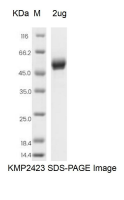Human CD137 Protein, His Tag
-
产品编号
KMP2423
-
别名
肿瘤坏死因子超家族受体9, CD137, ILA
-
规格
- 50ug
- 100ug
- 200ug
| Alias | 肿瘤坏死因子超家族受体9, CD137, ILA |
| Catalog Number | KMP2423 |
| Product Description | The Human CD137 Protein(KMP2423) is produced in HEK293 Cells and the target gene encoding Leu24-Gln186 is expressed with a 6His tag at the C-terminus. |
| Molecular Name | CD137 |
| Species | Human |
| Host | HEK293 Cells |
| Size | 50ug, 100ug, 200ug |
| Purity | >95% as determined by SDS-PAGE |
| Purification | Affinity purification |
| Endotoxin | <1.0 EU/ug determined by the LAL method |
| Formulation | PBS, pH7.4 |
| Background | Tumor necrosis factor receptor superfamily member 9(TNFRSF9), also known as CD137 and 4-1BB, is an inducible T cell surface protein belonging to the tumor necrosis factor receptor superfamily. It is a single-pass type I membrane protein which contains 4 TNFR-Cys repeats. The human and mouse proteins share 60% amino acid sequence identity. CD137 is expressed by mesenchymal cells, including endothelial cells, chondrocytes, and cells of the central nervous system. CD137 is also broadly expressed by cells of the human immune system, is broadly expressed by cells of the human immune system, including activated CD8+ and CD4+ T cells, activated natural killer(NK) cells, follicular dendritic cells(FDCs) and monocytes. CD137 has diverse roles in the immune response, the one key function is to promote the survival of both T cells and dendritic cells by binding the cognate ligand CD137L(4-1BBL). |
| SDS-PAGE |  |
| Predicted Molecular Weight | 18.11 kDa |
| Storage Condition | Aliquot and store at -20℃ to -80℃. Avoid repeated freezing and thawing cycles. |
| Shipping Condition | In general, the proteins are provided as lyophilized powder which are shipped at ambient temperature. They are shipped out in dry ice if supplied in liquid form. |
| Uniprot ID | Q12933 |
| References | 1.Genes Dev. 13:1297-1308 (1999) 2.Mol. Cell. Biol. 22:737-749 (2002) 3.Nature 416:345-347 (2002) 4.Nature 424:793-796 (2003) 5. Mol. Cell. Biol. 24:4502-4512 (2004) 6.J. Biol. Chem. 279:55855-55865 (2004) 7.Cell Rep. 3:724-733 (2013) |
| Function | Regulates activation of NF-kappa-B and JNK and plays a central role in the regulation of cell survival and apoptosis (PubMed:22212761). Required for normal antibody isotype switching from IgM to IgG. Has E3 ubiquitin-protein ligase activity and promotes 'Lys-63'-linked ubiquitination of target proteins, such as BIRC3, RIPK1 and TICAM1. Is an essential constituent of several E3 ubiquitin-protein ligase complexes, where it promotes the ubiquitination of target proteins by bringing them into contact with other E3 ubiquitin ligases. Regulates BIRC2 and BIRC3 protein levels by inhibiting their autoubiquitination and subsequent degradation; this does not depend on the TRAF2 RING-type zinc finger domain. Plays a role in mediating activation of NF-kappa-B by EIF2AK2/PKR. In complex with BIRC2 or BIRC3, promotes ubiquitination of IKBKE |





 0
0
